Plumbtree, Donald Wayne (Captain)
Killed in Flying Accident 1986-June-14
Service
RCAF
Unit
418 Sqn- Squadron
Piyautailili Defend even unto death: Inuktitut
Base
Rank
Captain
Position
Pilot
Service Numbers
V65603553
Home
 The Pas, Manitoba
The Pas, Manitoba
Crew or Other Personnel
Twin Otter 13807
Twin Otter serial: 13807

de Havilland CC-138 Twin Otter (Serial No. 13804) with a new yellow paint scheme, at Namao, CFB Edmonton, Alberta
The de Havilland Canada DHC-6 Twin Otter, currently marketed as the Viking Air DHC-6 Twin Otter, is a Canadian 19-passenger STOL (Short Takeoff and Landing) utility aircraft developed by de Havilland Canada, which produced the aircraft from 1965 to 1988; Viking Air purchased the type certificate, then restarted production in 2008. The aircraft's fixed tricycle undercarriage, STOL capabilities, twin turboprop engines and high rate of climb have made it a successful commuter passenger airliner as well as a cargo and medical evacuation aircraft. In addition, the Twin Otter has been popular with commercial skydiving operations, and is used by the United States Army Parachute Team and the United States Air Force's 98th Flying Training Squadron.
Development of the aircraft began in 1964, with the first flight on May 20, 1965. A twin-engine replacement for the single-engine DHC-3 Otter retaining DHC's renowned STOL qualities, its design features included double-slotted trailing-edge flaps and ailerons that work in unison with the flaps to boost STOL performance. The availability of the 550 shp (410 kW) Pratt & Whitney Canada PT6A-20 turboprop in the early 1960s made the concept of a twin more feasible. A DHC-3 Otter with its piston engine replaced with two PT6A-4 engines had already flown in 1963. It had been extensively modified for STOL research. To bush operators, the improved reliability of turboprop power and the improved performance of a twin-engine configuration made it an immediately popular alternative to the piston-powered Otter which had been flying since 1951.
CC-138 variant: Twin-engine STOL utility transport, search and rescue aircraft for the Canadian Forces. Based on the Series 300 aircraft.
After Series 300 production ended, the remaining tooling was purchased by Viking Air of Victoria, British Columbia, which manufactures replacement parts for all of the out-of-production de Havilland Canada aircraft. On February 24, 2006, Viking purchased the type certificates from Bombardier Aerospace for all the out-of-production de Havilland Canada aircraft (DHC-1 through DHC-7). The ownership of the certificates gives Viking the exclusive right to manufacture new aircraft.
Twin Otters could be delivered directly from the factory with floats, skis, or tricycle landing gear fittings, making them adaptable bush planes for remote and northern areas. Areas including Canada and the United States, (specifically Alaska) had much of the demand. Many Twin Otters still serve in the far north, but they can also be found in Africa, Australia, Asia, Antarctica, and other regions where bush planes are the optimum means of travel. Wikipedia
Unit Desciption
418 Sqn Piyautailili ("City of Edmonton")
History of the Squadron during World War II (Aircraft: Boston III, Mosquito II, FB Mk VI)

[Note that the squadron crest and motto were not given to the squadron until after WWII. During WWII the squadron had neither crest nor motto.] The squadron was formed at Debden, Essex, UK  in November 1941as the RCAF's only Intruder Squadron. As such, it was attached to 11 Group of Fighter Command (later renamed Air Defence of Great Britain), conducting day and night intruder operations. These involved a variety of targets, strategic attacks and intruder attacks on airfields. Originally the squadron flew Douglas Boston Mk. III, with the squadron code letters being TH. They flew from a number of airfields in the south of England from 1942 to 1944, namely Debden, Bradwell Bay, Ford, Holmsley South, Hurn, Middle Wallop and Hunsdon. In March 1943 the squadron re-equipped with de Havilland Mosquito Mks. II and F.B. VI aircraft., with a marked increase in their successes in destroying enemy aircraft. The squadron claimed its hundredth victory in May 1944. After D-Day the squadron was involved in the campaign against V-1 and V-2 weapons.
in November 1941as the RCAF's only Intruder Squadron. As such, it was attached to 11 Group of Fighter Command (later renamed Air Defence of Great Britain), conducting day and night intruder operations. These involved a variety of targets, strategic attacks and intruder attacks on airfields. Originally the squadron flew Douglas Boston Mk. III, with the squadron code letters being TH. They flew from a number of airfields in the south of England from 1942 to 1944, namely Debden, Bradwell Bay, Ford, Holmsley South, Hurn, Middle Wallop and Hunsdon. In March 1943 the squadron re-equipped with de Havilland Mosquito Mks. II and F.B. VI aircraft., with a marked increase in their successes in destroying enemy aircraft. The squadron claimed its hundredth victory in May 1944. After D-Day the squadron was involved in the campaign against V-1 and V-2 weapons.
On November 21, 1944 the squadron was transferred from Fighter Command to the 2nd Tactical Air Force in No. 136 (RAF) Wing and operated from Hartford Bridge, Hampshire, UK. before moving to Base 71 at Coxyde, Belgium, and then finally moving to Base 80 at Volkel, the Netherlands  . The squadron was disbanded there on September 7th 1945.
. The squadron was disbanded there on September 7th 1945.
The squadron was the most high-scoring unit of the RCAF in WWII. It claimed 178 aircraft and 79 and a half V-1 Flying Bombs. There were a number of aces, among them Wing Commander R. Bannock, DFC and Bar, Squadron Leader R. Gray, DFC, Flying Officer S.P. Reid DFC, Squadron Leader H.D. Cleveland DFC, Flight Lieutenant C.M. Jasper DFC, Flight Lieutenant J. Evans, Flight Lieutenant S.H.R. Cotterill DFC, Flight Lieutenant D.E. Forsyth, Squadron Leader J.B. Kerr, Flight Lieutenant H.E. Miller and Flight Lieutenant P.S. Leggatt. The squadron won 3 DSO's, 42 DFC's, 9 Bars to DFC's, 1 Second Bar to DFC, 5 DFM's, 1 DFC(USA) and 1 Air Medal (USA). Overall, 3492 sorties were flown, 402 of which were on anti-V-1 patrols. 11,248 hours were flown operationally for the loss of 59 aircraft. The squadron was credited with destroying 178 aircraft, 17 locomotives destroyed and 59 damaged, with other destruction of rolling stock and motor vehicles. Battle Honours were: Defence of Britain 1944, Fortress Europe 1942-44, Dieppe, France and Germany 1944-45, Normandy 1944, Rhine. Wikipedia, Kostenuk and Griffin
Map for Movements of 418 Squadron 1941-45
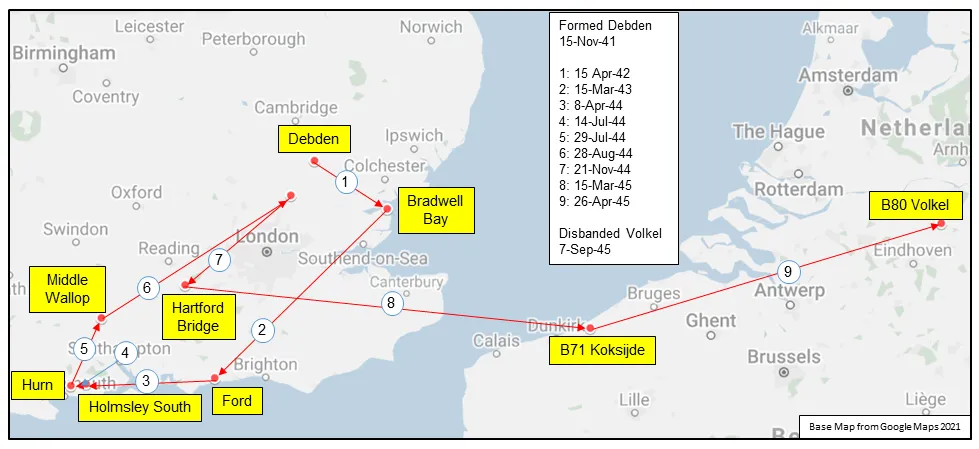
418 Squadron History Summary 1941-45
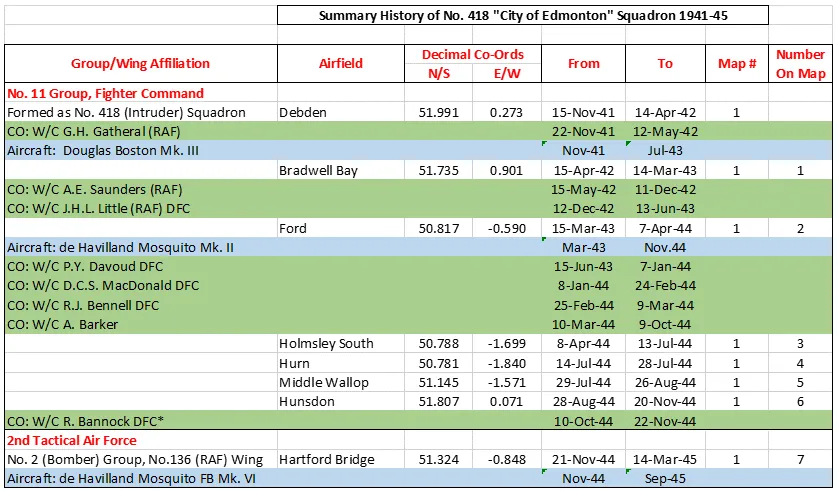
418 Squadron History Summary 1941-45 Page 2

History of the Squadron Post-WWII (Aircraft: Harvard II, Mitchell, Expeditor, Silver Star, Otter, Twin Otter, Kingfisher)
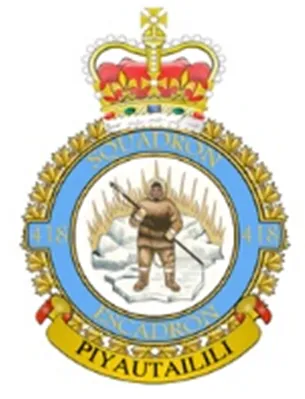
The squadron re-formed at Edmonton, Alberta  on 15 April 1946, flying North American B-5 Mitchell aircraft in a light bomber role. It moved to RCAF Station Namao, Alberta
on 15 April 1946, flying North American B-5 Mitchell aircraft in a light bomber role. It moved to RCAF Station Namao, Alberta  in 1955. In March 1958 it was reassigned to a light transport and emergency rescue role and was re-equipped with Beechcraft Expeditor and de Havilland Otter aircraft. Its duties ranged from aid to the civil power to aerial resupply. On 27 May 1967 it received a Squadron Standard for 25 years’ service. On 1 February 1968 the squadron was integrated into the Canadian Armed Forces as No. 418 “City of Edmonton†Air Reserve Squadron, and acquired de Havilland Twin Otter aircraft The squadron was disbanded in 1994, its aircraft being transferred to No 440 Transport Squadron.
in 1955. In March 1958 it was reassigned to a light transport and emergency rescue role and was re-equipped with Beechcraft Expeditor and de Havilland Otter aircraft. Its duties ranged from aid to the civil power to aerial resupply. On 27 May 1967 it received a Squadron Standard for 25 years’ service. On 1 February 1968 the squadron was integrated into the Canadian Armed Forces as No. 418 “City of Edmonton†Air Reserve Squadron, and acquired de Havilland Twin Otter aircraft The squadron was disbanded in 1994, its aircraft being transferred to No 440 Transport Squadron.
418 Squadron was re-formed on March 13, 2019, The unit is based at 19 Wing Comox, British Columbia  as 418 Search and Rescue Operational Training Squadron, training aircrew and maintenance personnel on the CC-295 Kingfisher, using simulators and aircraft, when the aircraft are delivered.
as 418 Search and Rescue Operational Training Squadron, training aircrew and maintenance personnel on the CC-295 Kingfisher, using simulators and aircraft, when the aircraft are delivered.



 Canadian Virtual War Memorial
Canadian Virtual War Memorial www.findagrave.com
www.findagrave.com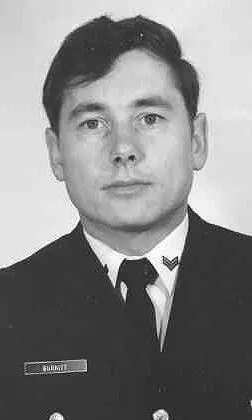
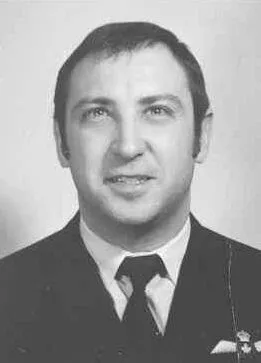
 Wikipedia de Havilland DHC-6 Twin Otter
Wikipedia de Havilland DHC-6 Twin Otter Harold A Skaarup Web Page
Harold A Skaarup Web Page CC-138 Twin Otter - Kestrel Publications
CC-138 Twin Otter - Kestrel Publications